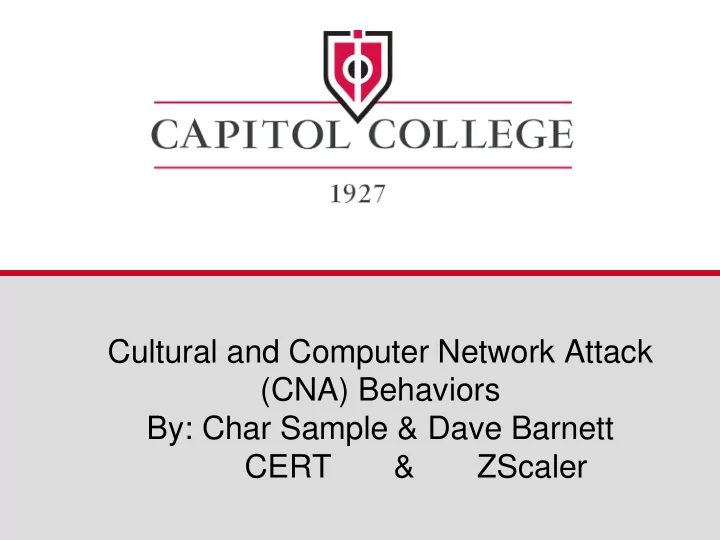

Cultural and Computer Network Attack (CNA) Behaviors By: Char Sample & Dave Barnett CERT & ZScaler
Cyber War Is Here
Rules are Being Discussed 1949 Geneva Convention 1868 St Petersburg Declaration
Sometimes Attribution is Obvious…
…Sometimes Not
We Need New Methods • What: We are trying to find a non-technical way to understand where an attack originates from. • Why: to allow us to better analyse the consequences of an attack and be able to take appropriate action • To answer the question: “Who did this to me?”
Here’s a thought... What if people subconsciously left their fingerprints in an attack?
Conscience vs Unconscious Thought 11,000,000 bps. 40-60 bps.
Conscience vs Unconscious Thought
Put it another way! System 360 Google People CAN NOT fool their unconscious
Cultural Studies • Hofstede, Hofstede & Minkov – Definition of culture: “the collective mental programming of the human mind which distinguishes one group of people from another”. • Dr. Dominick Guss – Culture influences problem perception, strategy development and the decision choices.
6 Cultural Dimensions • Power distance: • egalitarian vs hierarchy • Individualism: • individual vs collective • Masculinity: • masculine/feminine roles
6 Cultural Dimensions • Uncertainty avoidance: • fear of the unknown • Long term orientation • delayed vs immediate goals/results. • Indulgence vs restraint • fun vs self-restraint
Research Plan – Extract countries of origin from reports of specific website defacements for comparison against Hofstede’s data. • Hypothesis Tests: – There is no relationship between high PDI values or any other dimensional values and nationalistic, patriotic themed website defacements.
The question • Hypothesis Tests: – Easier to disprove a null. – Rules for considering alternative/ – Same test for each dimension.
Results – PDI PDI With Israel PDI Without Israel
Results – IVC IVC With Israel IVC Without Israel
Conclusions • Results – Statistically significant relationship between high PDI and low IVC dimensions and nationalistic, patriotic themed website attacks. – Statistically significant relationship between low PDI and high IVC dimensions and “lone wolf” attacking behaviors. – Notable observations in IVR and UAI. • Next Steps – Expand using larger datasets. – Change focus to examine for cultural traces in other activities such as software coding. • Conclusions – Culture does appear to influence attack behaviors. – Further research is needed. • Understand the role of each dimension’s role in cyber attacks. • Understand how this work fits with other efforts in cyber research.
Thank You! Q & A
BACKUP SLIDES • Unconscious thought – Dijksterhuis (2004): Unconscious thought does more processing than does conscious thought. • Conscious thought, single threaded approximately 40-60 bps. • Unconscious thought: multi-threaded approximately 11,000,000 bps. – Evans (2008): Speed of unconscious thought differs from speed of conscious thought. “Consciousness is also inherently slow, sequential, and capacity limited.” – Bargh and Morsella (2008): • “In nature, the ‘unconscious mind’ is the rule, not the exception.” • “Cultural norms and values are readily absorbed during the early phase of life; behaviors and values of those closest to us are also absorbed” • “Culture appears to permeate both unconscious thought and conscious thought”. – Gifford (2005) - Past events help to form future perceptions. (On-going Bayesian process) • Matching bias • Belief bias – Hofstede, Hofstede, & Minkov (2010); Minkov, 2013 • Unlearning habits or automatic thought processing is more difficult than learning the behavior. • Easier to learn and absorb cultural norms than to unlearn them. 18
Literature Review • Hofstede, Hofstede, and Minkov (2010) – Definition of culture: “Culture is defined as the collective mental programming of the human mind which distinguishes one group of people from another.” – Six dimensions of culture – Culture throughout life • Family • Education – Cognition – Technology • At work 19
Results (1) Results of Question One Test Without Israel _______________________________________________________________________ Hypothesis # Test Tool U= Z= p-value Accept/Reject _______________________________________________________________________ μ <= 59 Mann -Whitney (PDI) H1 0, H1 1 293 2.42 0.0078 Reject μ >= 45 Mann-Whitney (IVC) H1 0, H1 2 714.5 -2.35 0.0094 Reject μ >= 50 Z Test (M/F) H1 0, H1 3 n/a 0.5714 0.4247 Accept μ <= 68 Mann-Whitney (UAI) H1 0, H1 4 24.5 -1.33 0.0918 Accept μ <= 45 Mann -Whitney 500 (LTO) H1 0, H1 5 1.15 0.1251 Accept μ >= 45 Mann-Whitney (IVR) H1 0, H1 6 786 -1.51 0.0655 Accept _______________________________________________________________________ 20
Results (1) Truth Table Results for Research Question One PDI IVC M/F UAI LTOvSTO IVR _________________________________________________________ 1 1 0 0 0 0 _________________________________________________________ Note. 0 indicates the null hypothesis was accepted for the dimensional question and 1 indicates that the null hypothesis was rejected. 21
Recommend
More recommend